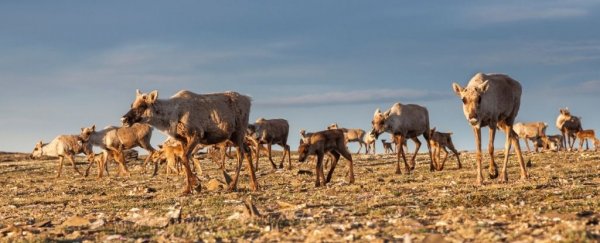The Arctic may no longer be the refuge it once was for migrating animals.
Scientists now fear that climate change and environmental degradation have turned the yearly journey of numerous species, including birds, butterflies and ungulates, into an ecological trap.
Upon reaching their destination, many animals are likely starving, being hunted or dying of disease at much higher rates than before.
"These findings are alarming," says evolutionary ecologist Vojtěch Kubelka from the University of Bath in the UK.
"We have lived with the notion that northern breeding grounds represent safe harbors for migratory animals."
But that assumption is probably outdated. Human activity has likely undermined the natural advantages of migrating to northern latitudes for many animals.
Already, research has shown migrating animals are suffering more in modern times than animals that reside in one place. And it's not just the journey that puts them in more danger; even once the destination is reached, that's no guarantee of safety or survival.
Arctic ecosystems are changing rapidly with human activity, and emerging evidence suggests recent decades have brought more pathogens and parasites, as well as an added increase in predators and a reduction in available food.
Migration was always an incredibly risky survival strategy, but lately, it seems to have become even more dangerous, with far fewer upsides.
When researchers analyzed 25 recent studies on modern Arctic migration, they noticed three common themes: these journeys weren't necessarily leading to more food, they were likely putting the animals at greater risk of predation, and they were probably exposing them to more parasites and pathogens.
The lack of food seems to occur from a seasonal mismatch in when an animal is arriving in the north and when its main source of nutrition is available.
This is either because climate change is causing some plants to produce (or insects to emerge) earlier or later than they commonly would, or climate change is causing animals to start their migration earlier or later than normal.
For animals that migrate to breed, this could very well lead to higher offspring mortality, as the parents aren't able to feed their children as well as they once could.
These migrating families could also face more predators. Climate change, for instance, seems to have reduced the number of rodents available in some parts of the icy north, which means that carnivores that usually survive on voles and lemmings could be turning their attention to other easy prey.
"Lemmings and voles used to be the main food source for predators such as foxes in the Arctic, however the milder winters can cause rain to fall on snow and then re-freeze, preventing the lemmings from reaching their food," explains Kubelka.
"With fewer lemmings and voles to feed on, foxes eat the eggs and chicks of migratory birds instead. We've seen that rates of nest predation of Arctic migratory shorebirds have tripled over the last 70 years, in large part due to climate change."
We even have some evidence that starving polar bears are feasting more on colonies of geese, ducks, gulls, and auks, as they comb the coasts instead of traveling along sea ice.
Even if a colony of migrating birds or ungulates manages to find enough food and avoid being hunted by local predators, they can still easily fall prey to sickness or disease.
While it's hard to say how much parasite numbers have increased historically in the Arctic (we don't have great baseline data), it seems like recent years have brought an uptick in some species.
Avian cholera outbreaks, for instance, have recently emerged in the nests of some birds in the Canadian Arctic, while migrating antelopes in Kazakhstan have died by the hundreds of thousands due to a fatal bacterial infection of the blood, thought to be driven by rising heat and humidity.
"Animal migration from equatorial regions to the North temperate and the Arctic is one of the largest movements of biomass in the world," says evolutionary biologist Tamás Székely from the University of Bath.
"But with reduced profitability of migration behavior and smaller number of offspring joining the population, the negative trend will continue and fewer and fewer individuals will be returning back to the North."
The study authors worry that if even a few migrating animals go extinct, it could reshuffle the Arctic food web and trigger a series of cascading disasters for the ecosystem as a whole.
As such, the team is calling for greater protection and conservation of migratory breeding grounds in the Arctic. This is where life begins for many species, but it could also be the very place where life ends.
The study was published in Trends in Ecology & Evolution.
